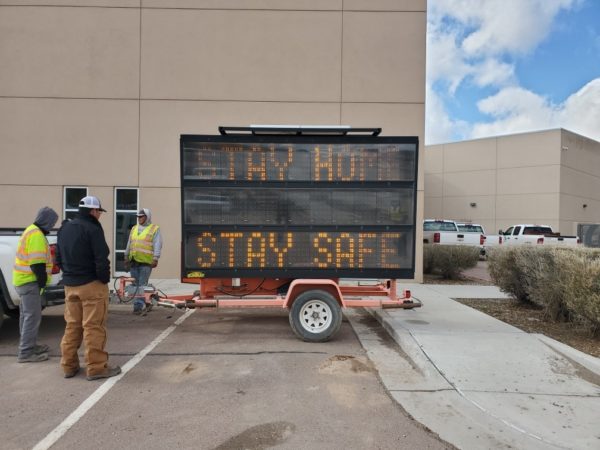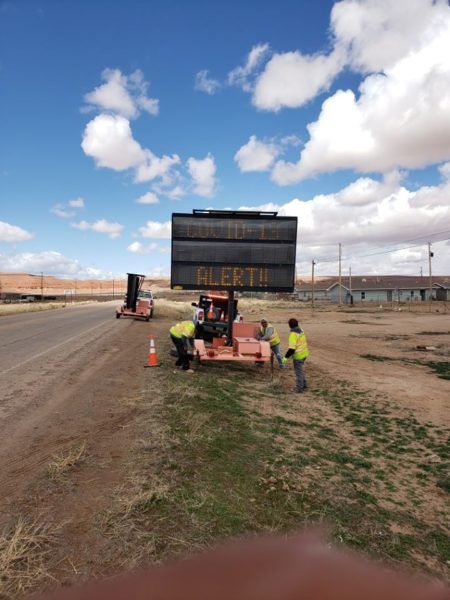
- Details
- By Press Releases
From Press Release
WINDOW ROCK, Ariz. — On Friday, the Navajo Nation Health Command Operations Center issued a Public Health Emergency “Stay at Home Order” requiring all residents of the Navajo Nation to remain home and isolated and all non-essential businesses to close to prevent the further spread of the COVID-19 coronavirus.
The previous shelter-in-place order for the community of Chilchinbeto in now expanded to the entire Navajo Nation.
 Crews working on Friday on Navajo Nation to get safe messages along reservation. (courtesy photo)
Crews working on Friday on Navajo Nation to get safe messages along reservation. (courtesy photo)
“We are getting many reports of people still being out in public and putting elders and everyone at risk. This is a very serious situation and if need be, we will take steps to enforce the “Stay at Home Order” even more. The more people go out in public, the greater the risk is for a massive health crisis on the Navajo Nation. We are telling our people to stay home to protect themselves and others, which will help our health professional take care of those who need medical attention,” said President Nez.
In a short period of time, COVID-19 has arrived on the Navajo Nation and the number of cases remains at 14 as of Friday. The degree of contact of contagious individuals and the subsequent degree of exposure is unknown and continued person-to-person spread throughout the Navajo Nation thereby poses an extensive and substantial public health risk, according to the order.
“While there are a higher number of people receiving negative COVID-19 test results for the virus at this point, there are many tests that are awaiting results and confirmation. The purpose of the closure is to allow the Navajo Nation as a whole to isolate and quarantine. Isolation and quarantine help protect our Nation by preventing exposure to people who have or may have the contagious COVID-19 virus. Isolation separates people who may be sick with COVID-19 from people who are not sick. Quarantine separates and restricts the movement of people who were exposed to a contagious disease to see if they become sick,” President Nez added.
The order also outlines provisions for “essential activities, essential businesses, and any work necessary to the operations and maintenance of essential infrastructure.” It further states that Navajo Nation citizens are required to stay home and undertake only those outings absolutely necessary for their health, safety, or welfare as described herein.

“It’s incumbent of every person to comply with this order. Our ancestors have been through much worse and we need to remember that. We are going to get through this with the power of prayer. Please continue to be mindful of our elders and those at high-risk. COVID-19 is extremely dangerous for our elders, for people over 60. Think of the safety of our elders. Stay home,” added Vice President Lizer.
On Friday, President Nez and Vice President Lizer also approved a $4 million appropriation that will be directed to the Navajo Department of Health to fight the spread of the COVID-19 pandemic on the Navajo Nation and deliver much-needed resources and equipment to health care experts and emergency response personnel on the ground. The funding will provide medical supplies, food and water supplies, equipment, public outreach, and more.
To view the entire “Stay at Home Order,” please visit: http://www.ndoh.navajo-nsn.gov/.
More Stories Like This
Native News Weekly (August 25, 2024): D.C. BriefsUS Presidents in Their Own Words Concerning American Indians
Native News Weekly (December 14, 2025): D.C. Briefs
Wounded Knee Massacre Site Protection Bill Passes Congress
Two Murdered on Colville Indian Reservation
Help us defend tribal sovereignty.
At Native News Online, our mission is rooted in telling the stories that strengthen sovereignty and uplift Indigenous voices — not just at year’s end, but every single day.
Because of your generosity last year, we were able to keep our reporters on the ground in tribal communities, at national gatherings and in the halls of Congress — covering the issues that matter most to Indian Country: sovereignty, culture, education, health and economic opportunity.
That support sustained us through a tough year in 2025. Now, as we look to the year ahead, we need your help right now to ensure warrior journalism remains strong — reporting that defends tribal sovereignty, amplifies Native truth, and holds power accountable.
 The stakes couldn't be higher. Your support keeps Native voices heard, Native stories told and Native sovereignty defended.
The stakes couldn't be higher. Your support keeps Native voices heard, Native stories told and Native sovereignty defended.
Stand with Warrior Journalism today.
Levi Rickert (Potawatomi), Editor & Publisher
